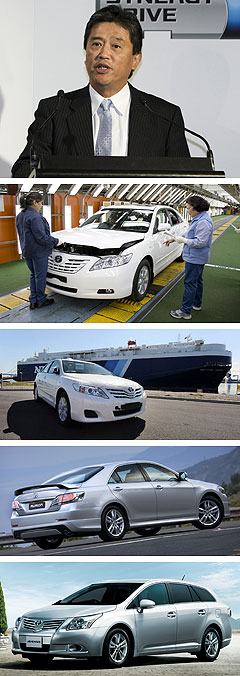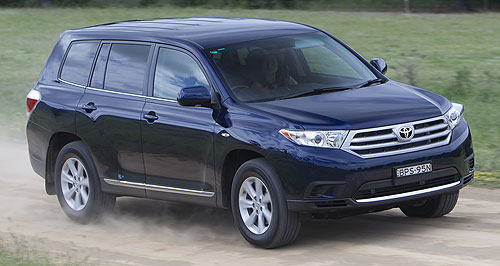Make / Model Search
News - Toyota - CamryToyota Oz still wants third model lineProduction possibilities: Toyota may still build a third, Camry-based model in Australia, possibly the Kluger (digital image of seventh-generation Camry to the left). Kluger production remains a chance for Australia despite green-car fund cut5 Jul 2011 TOYOTA Australia’s near-decade-old desire to manufacture a third model at Altona has not been dampened by the demise of the federal government’s Green Car Innovation Fund. However, the decision to build a model based on October’s seventh-generation Camry – alongside it and next year’s all-new Aurion – remains complicated by Australia’s strong currency, low import tariffs and vehicle downsizing trends. Toyota Australia’s original plan to manufacture the Kluger here – revealed by GoAuto in 2003 – never came to fruition during the life of the current Camry (2006-2011), but GoAuto has learned Toyota is in the early stages of planning a new model based on the redesigned Camry due for release in just three months. “There is always the possibility, but there are only very primitive discussions at this point of time,” said Toyota Australia president and CEO Max Yasuda when asked by GoAuto at Friday’s Australian International Motor Show opening if Toyota still wanted to produce the mid-size crossover wagon at Altona. The third-generation Kluger, due for release by around 2013, will not be produced in Japan (from where Australia’s current model is sourced), leaving Toyota Australia with two choices: secure right-hand drive production at Toyota’s US Kluger/Highlander plant in Indiana or build the new model itself. “I think that Japan is not producing Kluger any more and the only place they build Kluger is in the US,” said Mr Yasuda of the MkIII Kluger.  From top: Toyota Australia president and CEO Max Yasuda, Camry production at Altona, a Camry ready for export, Aurion, Japanese-spec Avensis. From top: Toyota Australia president and CEO Max Yasuda, Camry production at Altona, a Camry ready for export, Aurion, Japanese-spec Avensis.Asked if Australia’s next Kluger would be imported from the US, Mr Yasuda said: “I cannot say that but you can guess.” When quizzed about the prospect of an Australian-made Kluger finally becoming reality, the local Toyota chief said: “I’m not sure. It’s very difficult to say. We spent so much resource already building this Camry, hybrid Camry and Aurion. “I’m asking our sales and marketing people to really understand the market trend in Australia … and based upon this study I think we can come up with some idea about which model we should produce here.” Toyota Australia has always said that if it produced a third model at its Victorian plant it would be based on the Toyota Modular Platform (TMP) or ‘MC’ chassis architecture that underpins the Camry and Aurion. Potentially, that means Toyota’s suburban Melbourne factory could produce anything from the Kluger, Venza, RAV4 and Lexus RX SUVs, to the Avensis people-mover or a number of small cars including the Corolla, Prius or even the Lexus CT200h. While Toyota’s next Kluger remains the prime candidate for production alongside the Camry and Aurion sedans, GoAuto understands dwindling medium SUV sales in Australia this year, the lack of a locally built V6 and the absence of a Camry wagon in the face of a renewed mid-size model onslaught from Hyundai and a Cruze wagon from Holden could see Toyota favour an Australian-built version of either the next RAV4 or Avensis – with both 2.5-litre petrol and hybrid powertrains. Mr Yasuda said Toyota’s Australian operations were locked in for the life of the next Camry or until at least 2016, but stressed that investment in any new model during or after that time would not occur without government assistance. “For new investment we need some kind of assistance. For the current operations we are okay. Camry, hybrid Camry and Aurion production is all locked in – it’s what comes next after 2016-17,” he said. The Gillard government axed the $1.3 billion green-car fund in January to help pay for Queensland’s flood reconstruction, although applications submitted before the cut-off are still being processed. While Holden has received $189 million in GCIF handouts – more than half of the $340 million provided to car companies and automotive component suppliers to date – Toyota was given $63 million towards a new $331 million 2.5-litre four-cylinder engine plant to come online by September 2012, in addition to $35 million to build the outgoing Camry hybrid. The local Toyota chief stopped short of echoing “aggressive” comments made by his opposite number at GM Holden, FCAI president Mike Devereux, who last week told ABC radio the ‘green’ funding cut put Australia at risk of becoming “a hole in the ground for south-east Asia to pull minerals out of and then shift finished goods back to…” But Mr Yasuda said a replacement for the GCIF would be among discussions between Toyota’s regional head office in Thailand and federal industry minister Kim Carr when he visits Bangkok later this month. Senator Carr held similar meetings with Ford and GM executives in the US last week. “Of course, we’d like to talk about Green Car Innovation Fund,” he said. “What is the replacement of this GCIF? “We need support from the government to continue in sort of a co-partnership to sustain our production facilities here because as you can imagine the manufacturing base in Australia is very fragile and this market is so open to everyone with a very low tariff.” Despite increased export revenue of $1.4 billion and increased total sales of 217,365 vehicles in its financial year ending on March 31, Toyota a week ago posted a $13.2 million net loss after an unspecified tax adjustment to previous years. Mr Yasuda said the new Camry remains on target for launch in October, before a new Camry hybrid and Aurion large sedan arrive in the first quarter of 2012. “Fortunately we are on target for production,” he said. “At the time of turmoil the earthquake impact was of concern, but fortunately we can launch at original timing, which is October. Hybrid and Aurion follow early next year – within six months definitely.” The new Camry has already been shown to American Toyota dealers at an extravagant unveiling ceremony, and is set to go public in August. Toyota’s Australian manufacturing operations are underpinned by the Camry, with more than 95,000 examples of the mid-size sedan produced at Altona last year – more than 70,000 of which were exported to more than 20 countries, mostly in the Middle East. However, Mr Yasuda suggested a major export deal with Thailand could be in the offing for the Altona-built model. “Thailand produces 30,000 Camrys per year and if we are competitive we have a good chance to bring that into Australia and export to Thailand,” he said, before cautioning: “Nothing has been decided yet. There is potential, but not big volume.” Mr Yasuda said Camry exports to the Middle East would continue with the next generation but “the volume is not guaranteed because the market is struggling right now”. He admitted the next-generation Aurion would be a hard sell in a declining large-car market, saying: “The market trend is shifting down to smaller cars. In that sense we may have some struggle to sell the car, but it comes down to the ability of our marketing people…” Toyota hopes to remain profitable without a replacement for the green-car fund, said Mr Yasuda, adding: “We will try, but with current exchange rates export especially to the Middle East is very tough to make a profit. “It is very serious and we are doing everything to reduce our cost but that’s not enough because the exchange rate is so high and the competition in the Middle East is getting tough from the Korean cars. “It will certainly help to sustain our business here especially in the manufacturing side to have government support. I think it’s almost mandatory.” Mr Yasuda said the potential for production of a third model such as the next Kluger at Altona “becomes bigger if we have this kind of fund to support the new product – it will certainly help.” However, the Toyota Australia boss said he believed the federal government, whose green-car fund was just one part of its $5.4 billion ‘New Car Plan for a Greener Future’ until 2020, was still open for funding discussions. “I think there is some impact for our headquarters to make future investment decisions (as a result of the GCIF’s axing), but as far as I’m talking with the government right now they are very interested to talk case by case even though there is no GCIF. “The minister is telling us ‘please come to us and discuss with us before making any decisions’, so I’m not so pessimistic about the abolition of GCIF. “Of course, it hurt and it has a bad image for our head office – Australian government is no longer interested in manufacturing – but it’s not the case. “So I’m telling our people back in Japan that we are still very much interested in keeping production here in Australia and each future investment we can talk to the government about. “It’s not really a definitive promise from the government but I do have confidence that if we have a really good plan or proposal we can sit down and discuss with the government.” Mr Yasuda was less reserved about the implementation of a federal carbon tax, which he said would impact heavily on its ability to be a competitive exporter. “We are competing in an export market and if a carbon tax is levied on our cars and cars coming from other parts of the world have no levies then obviously we are disadvantaged,” he said. “But I’m still waiting for the government to come up with a clear plan in terms of a transitional scheme that shows support for trade export-exposed business.” Mr Yasuda said he doubted any potential change in government would impact Toyota’s ability to secure sufficient funding for investments such as a third model line, saying: “I’m not concerned because we have a long history of working with any government and they are all supportive to our initiatives”.  Read more28th of June 2011  Aussie trim and tuck for Toyota SUVToyota’s Asian-focussed Fortuner SUV gets Melbourne makeover27th of June 2011  AIMS: Toyota Oz chased Camry show-stopperNew Toyota Camry sought for Melbourne show, but missed by that much...27th of June 2011  AIMS: Celica out, 86 in at ToyotaBoxer sports coupe likely to wear Toyota 86 tag instead of Celica in Australia27th of June 2011  AIMS: Toyota confirms city PriusThrifty Toyota Prius C to set new hybrid benchmark when it arrives in 201227th of June 2011  Toyota Australia posts $13.2m lossSecond consecutive loss for Toyota Australia following another tax adjustment |
Click to shareToyota articlesResearch Toyota Camry pricing
Motor industry news |











Facebook Twitter Instagram